radiator TOYOTA YARIS SEDAN 2010 Owners Manual
[x] Cancel search | Manufacturer: TOYOTA, Model Year: 2010, Model line: YARIS SEDAN, Model: TOYOTA YARIS SEDAN 2010Pages: 386, PDF Size: 6.95 MB
Page 234 of 386
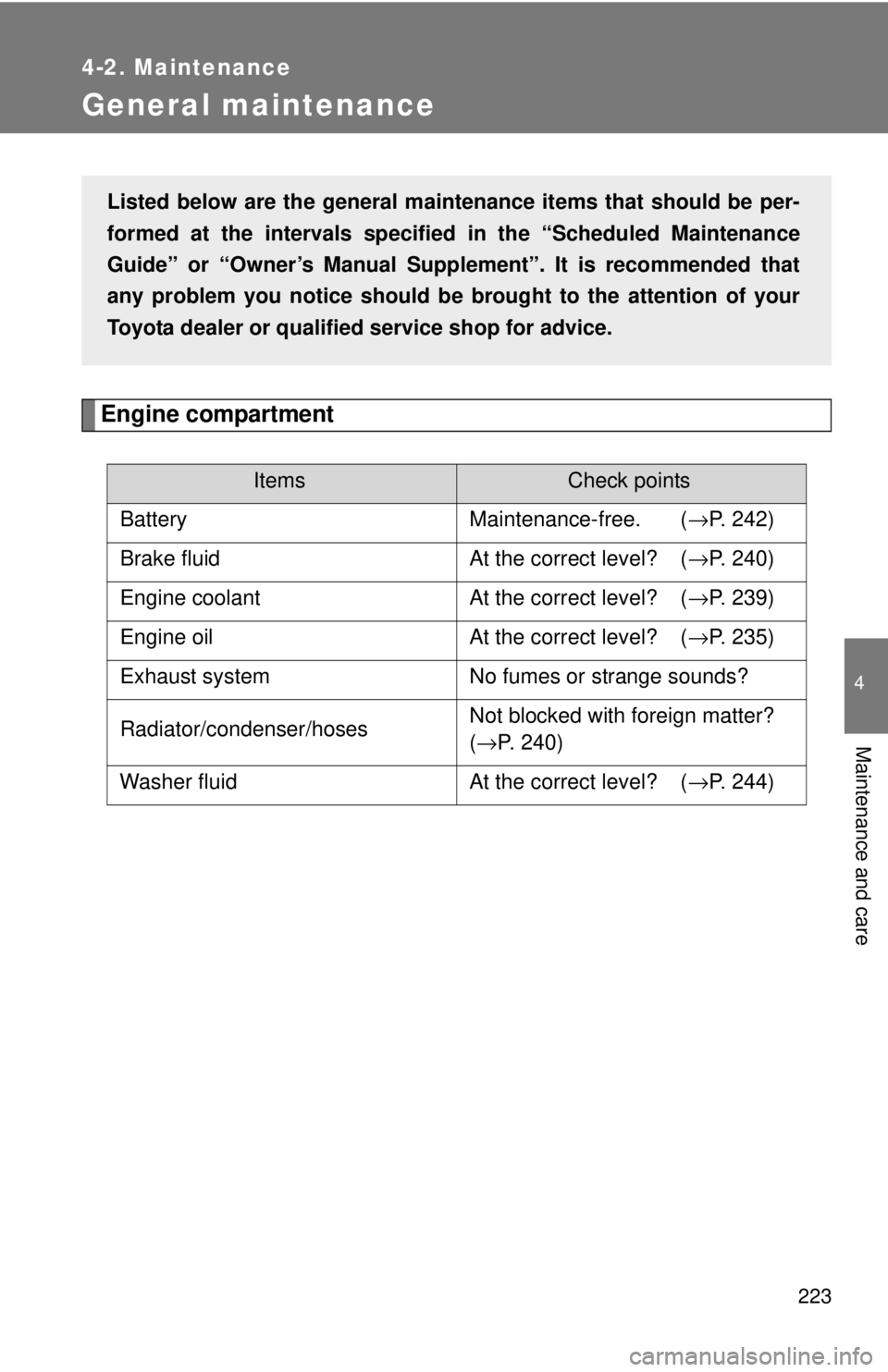
223
4-2. Maintenance
4
Maintenance and care
General maintenance
Engine compartment
ItemsCheck points
Battery Maintenance-free. ( →P. 242)
Brake fluid At the correct level? ( →P. 240)
Engine coolant At the correct level? ( →P. 239)
Engine oil At the correct level? ( →P. 235)
Exhaust system No fumes or strange sounds?
Radiator/condenser/hoses Not blocked with foreign matter?
(
→P. 240)
Washer fluid At the correct level? ( →P. 244)
Listed below are the general maintenance items that should be per-
formed at the intervals specified in the “Scheduled Maintenance
Guide” or “Owner’s Manual Supp lement”. It is recommended that
any problem you notice should be brought to the attention of your
Toyota dealer or qualified service shop for advice.
Page 239 of 386
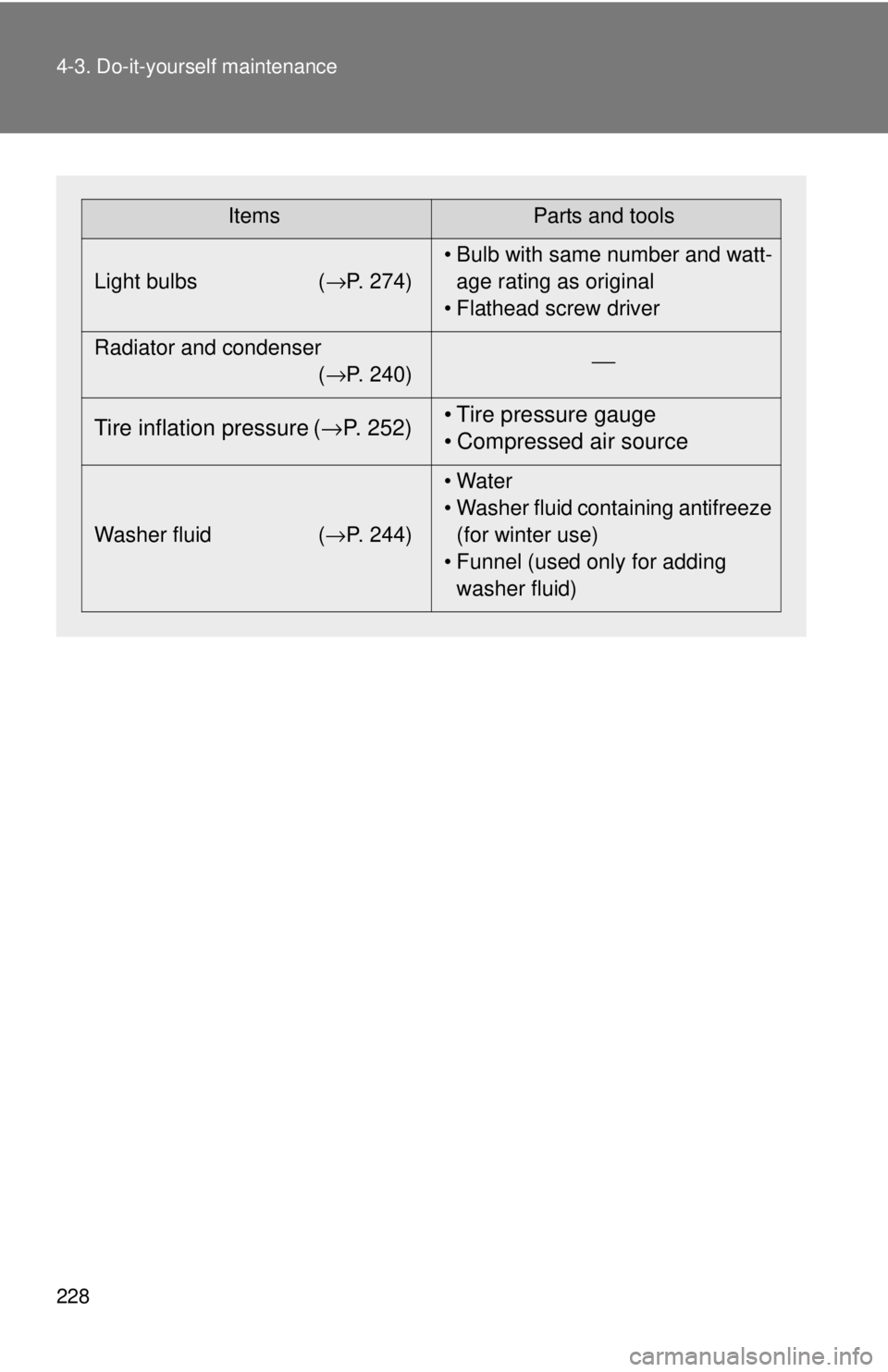
228 4-3. Do-it-yourself maintenance
ItemsParts and tools
Light bulbs ( →P. 274)• Bulb with same number and watt-
age rating as original
• Flathead screw driver
Radiator and condenser (→P. 240) ⎯
Tire inflation pressure (
→P. 252) • Tire pressure gauge
• Compressed air source
Washer fluid
(→P. 244) • Water
• Washer fluid containing antifreeze
(for winter use)
• Funnel (used only for adding washer fluid)
Page 240 of 386
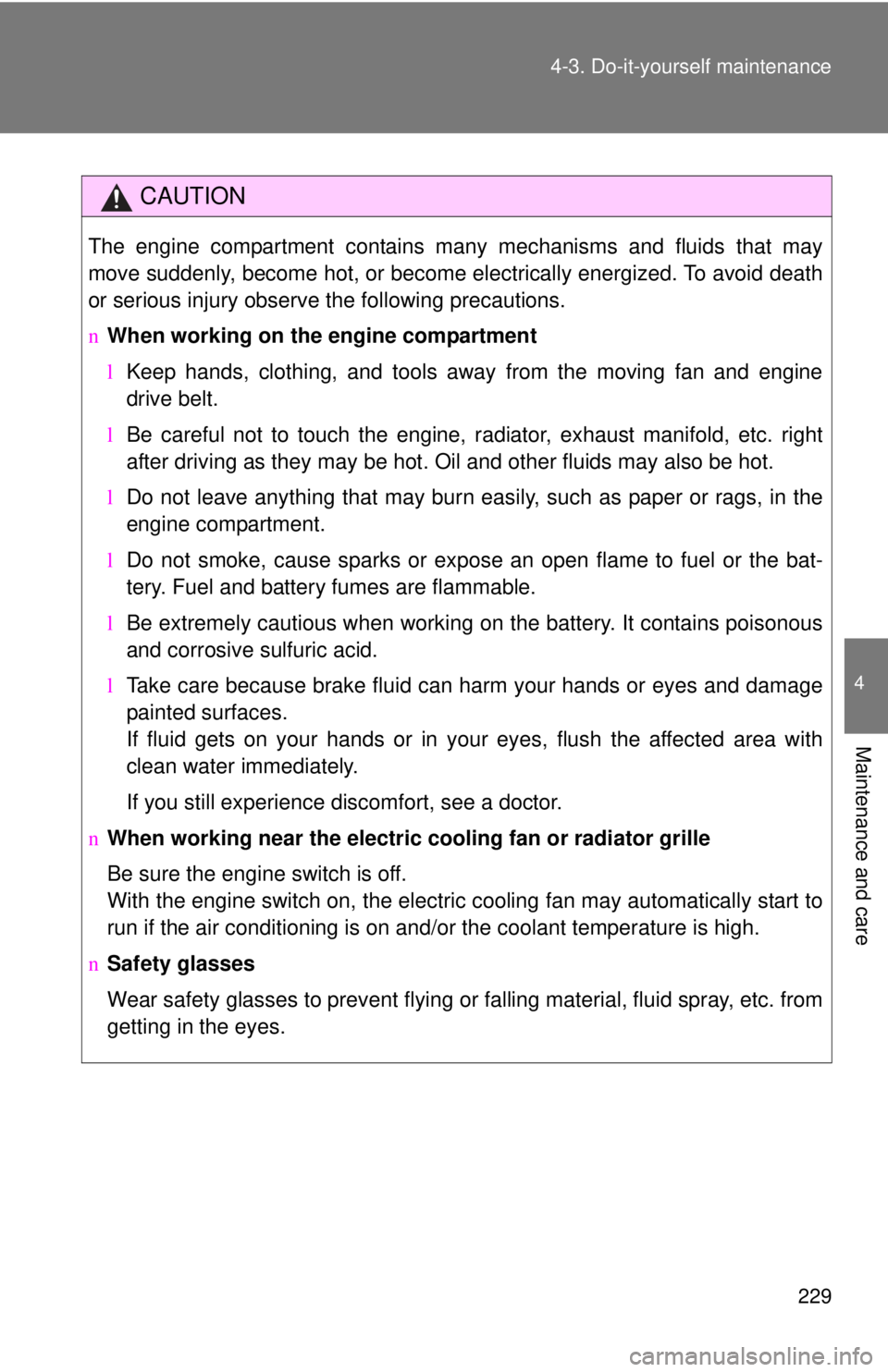
229
4-3. Do-it-yourself maintenance
4
Maintenance and care
CAUTION
The engine compartment contains many mechanisms and fluids that may
move suddenly, become hot, or become electrically energized. To avoid death
or serious injury observe the following precautions.
n
When working on the engine compartment
lKeep hands, clothing, and tools away from the moving fan and engine
drive belt.
l Be careful not to touch the engine, radiator, exhaust manifold, etc. right
after driving as they may be hot. Oil and other fluids may also be hot.
l Do not leave anything that may burn easily, such as paper or rags, in the
engine compartment.
l Do not smoke, cause sparks or expose an open flame to fuel or the bat-
tery. Fuel and battery fumes are flammable.
l Be extremely cautious when working on the battery. It contains poisonous
and corrosive sulfuric acid.
l Take care because brake fluid can harm your hands or eyes and damage
painted surfaces.
If fluid gets on your hands or in your eyes, flush the affected area with
clean water immediately.
If you still experience discomfort, see a doctor.
n When working near the electric cooling fan or radiator grille
Be sure the engine switch is off.
With the engine switch on, the electric cooling fan may automatically start to
run if the air conditioning is on and/or the coolant temperature is high.
n Safety glasses
Wear safety glasses to prevent flying or falling material, fluid spray, etc. from
getting in the eyes.
Page 245 of 386
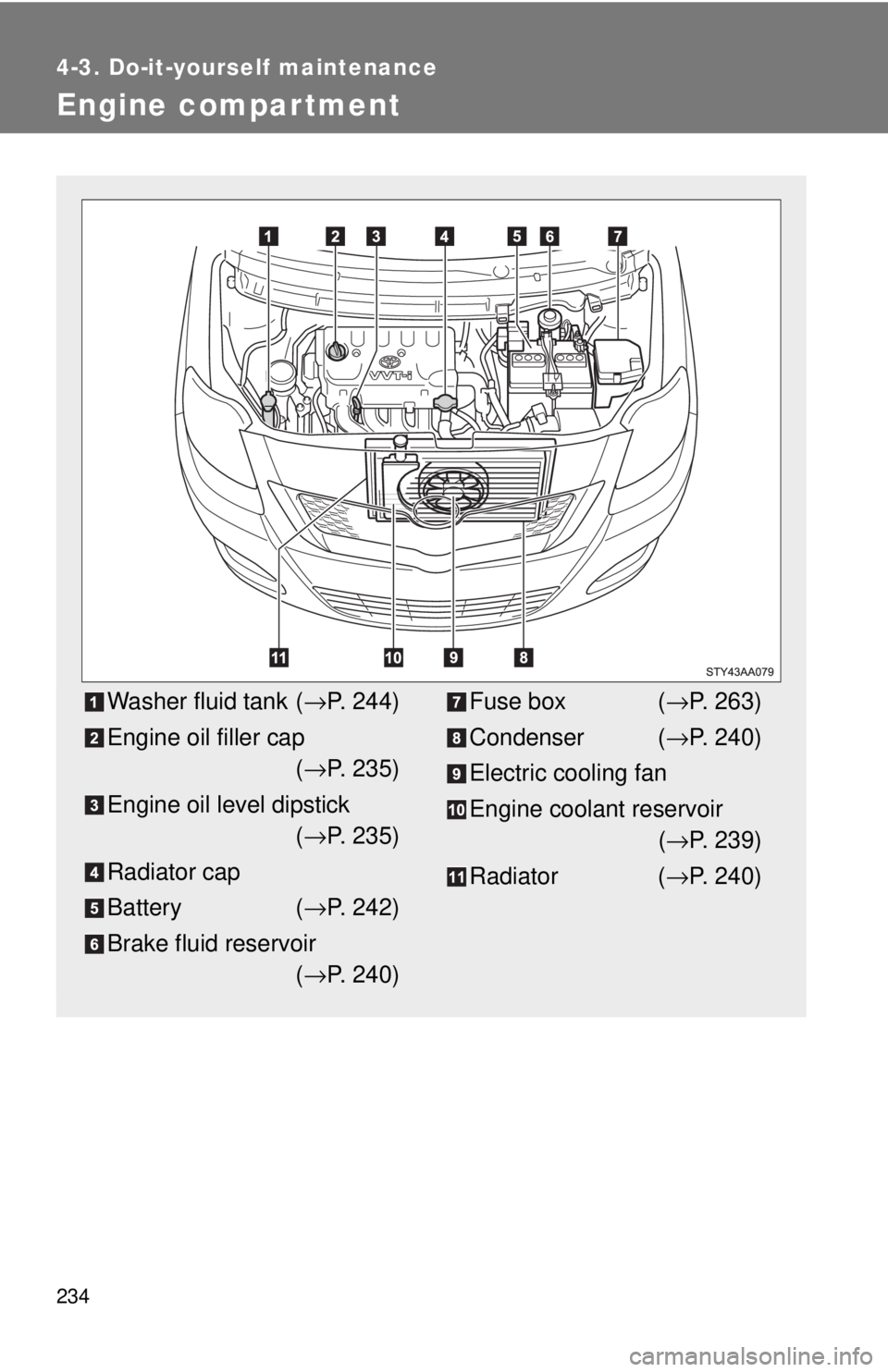
234
4-3. Do-it-yourself maintenance
Engine compar tment
Washer fluid tank (→P. 244)
Engine oil filler cap (→ P. 235)
Engine oil level dipstick (→ P. 235)
Radiator cap
Battery ( →P. 242)
Brake fluid reservoir (→ P. 240)Fuse box ( →P. 263)
Condenser ( →P. 240)
Electric cooling fan
Engine coolant reservoir (→ P. 239)
Radiator ( →P. 240)
Page 250 of 386
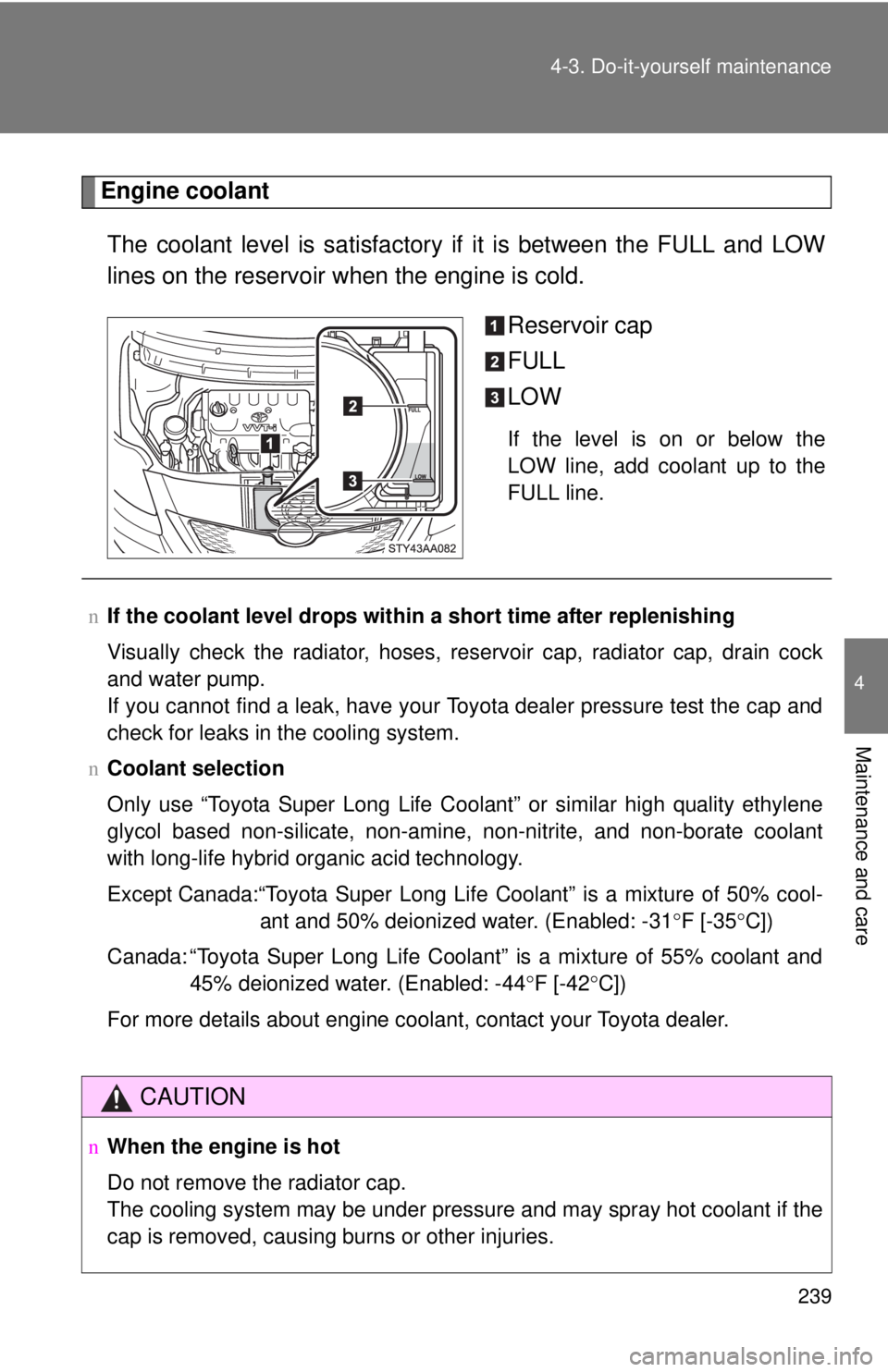
239
4-3. Do-it-yourself maintenance
4
Maintenance and care
Engine coolant
The coolant level is satisfactory if it is between the FULL and LOW
lines on the reservoir when the engine is cold.
Reservoir cap
FULL
LOW
If the level is on or below the
LOW line, add coolant up to the
FULL line.
nIf the coolant level drops within a short time after replenishing
Visually check the radiator, hoses, reservoir cap, radiator cap, drain cock
and water pump.
If you cannot find a leak, have your Toyota dealer pressure test the cap and
check for leaks in the cooling system.
n Coolant selection
Only use “Toyota Super Long Life Coolant” or similar high quality ethylene
glycol based non-silicate, non-amine, non-nitrite, and non-borate coolant
with long-life hybrid organic acid technology.
Except Canada:“Toyota Super Long Life Coolant” is a mixture of 50% cool- ant and 50% deionized water. (Enabled: -31 °F [-35 °C])
Canada: “Toyota Super Long Life Coolant” is a mixture of 55% coolant and 45% deionized water. (Enabled: -44 °F [-42 °C])
For more details about engine coolant, contact your Toyota dealer.
CAUTION
n When the engine is hot
Do not remove the radiator cap.
The cooling system may be under pressure and may spray hot coolant if the
cap is removed, causing burns or other injuries.
Page 251 of 386
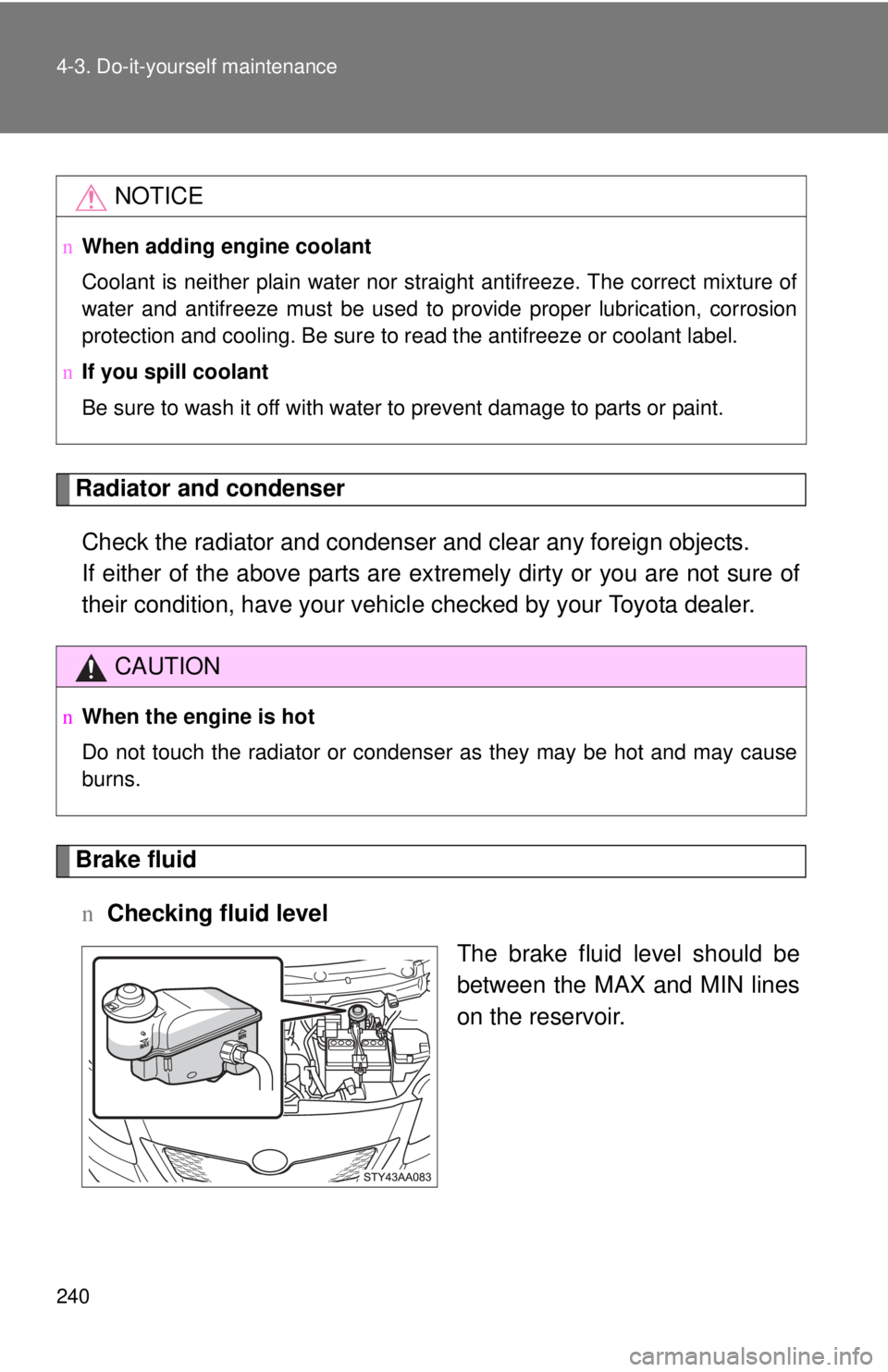
240 4-3. Do-it-yourself maintenance
Radiator and condenserCheck the radiator and condenser and clear any foreign objects.
If either of the above parts are ex tremely dirty or you are not sure of
their condition, have your vehicl e checked by your Toyota dealer.
Brake fluid
n Checking fluid level
The brake fluid level should be
between the MAX and MIN lines
on the reservoir.
NOTICE
nWhen adding engine coolant
Coolant is neither plain water nor stra ight antifreeze. The correct mixture of
water and antifreeze must be used to provide proper lubrication, corrosion
protection and cooling. Be sure to read the antifreeze or coolant label.
n If you spill coolant
Be sure to wash it off with water to prevent damage to parts or paint.
CAUTION
nWhen the engine is hot
Do not touch the radiator or condenser as they may be hot and may cause
burns.
Page 336 of 386
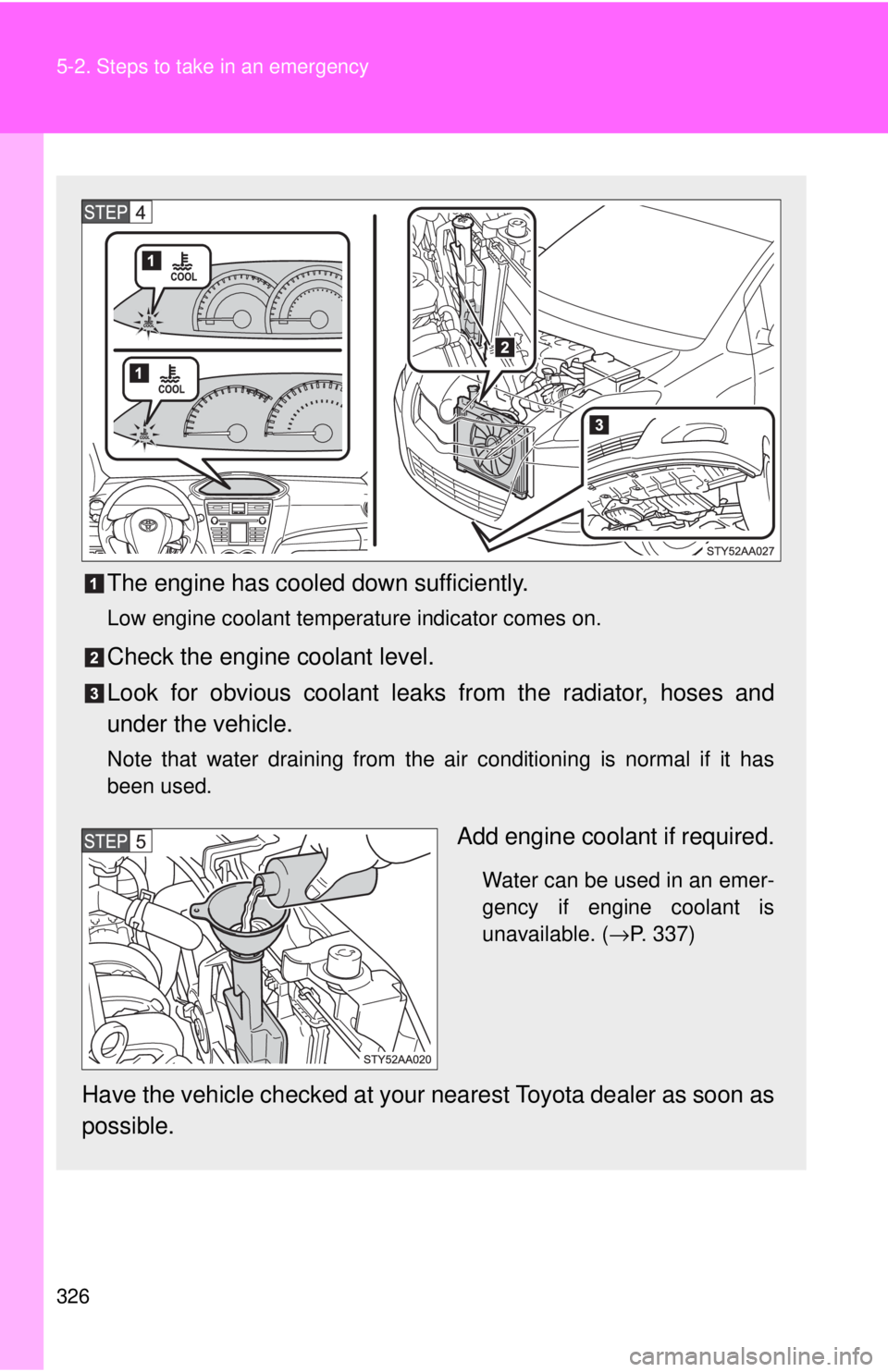
326 5-2. Steps to take in an emergency
The engine has cooled down sufficiently.
Low engine coolant temperature indicator comes on.
Check the engine coolant level.
Look for obvious coolant leaks from the radiator, hoses and
under the vehicle.
Note that water draining from the air conditioning is normal if it has
been used.
Add engine coolant if required.
Water can be used in an emer-
gency if engine coolant is
unavailable. ( →P. 337)
Have the vehicle checked at your nearest Toyota dealer as soon as
possible.
Page 337 of 386
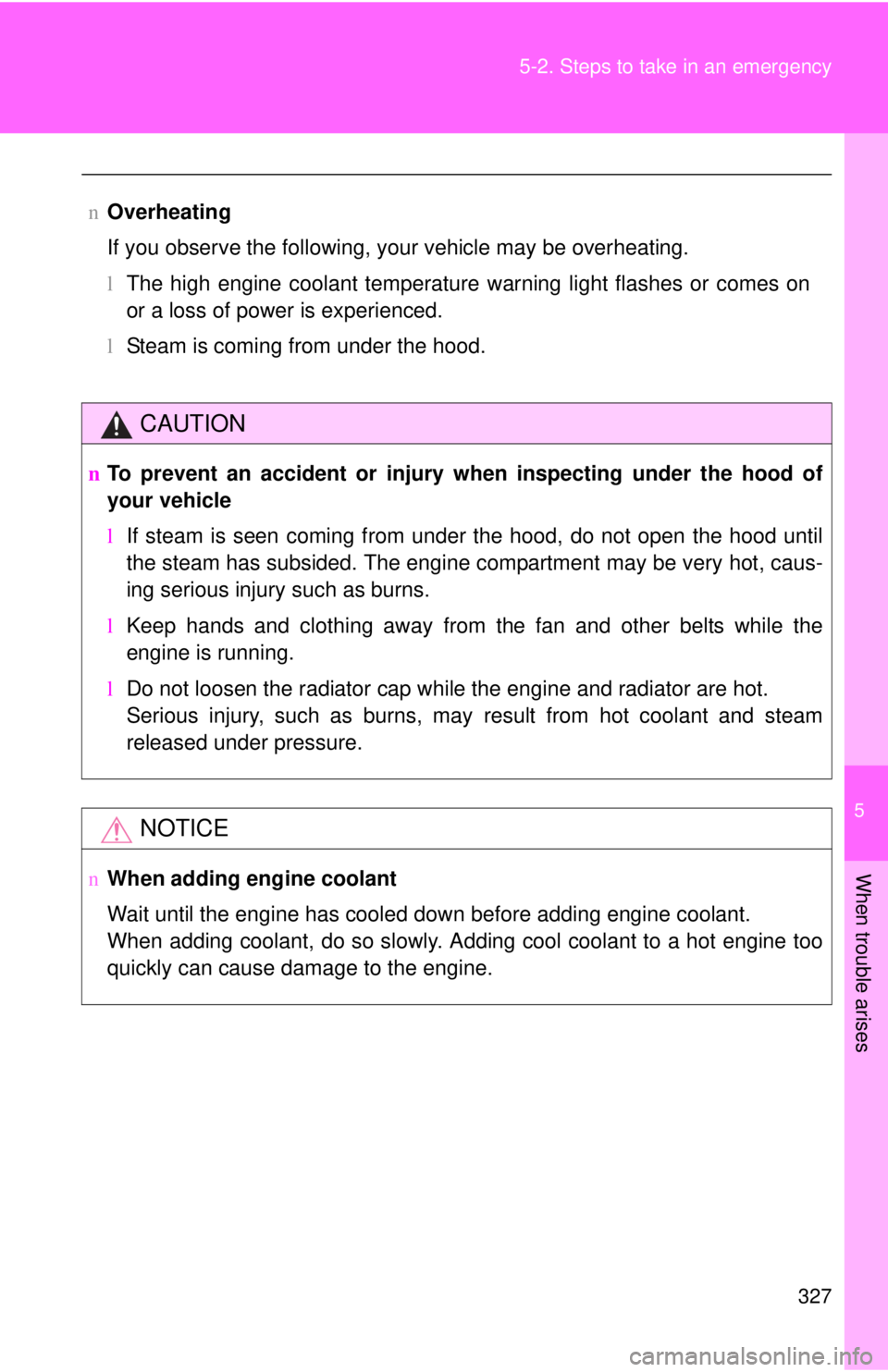
5
When trouble arises
327
5-2. Steps to take in an emergency
n
Overheating
If you observe the following, your vehicle may be overheating.
lThe high engine coolant temperature warning light flashes or comes on
or a loss of power is experienced.
l Steam is coming from under the hood.
CAUTION
nTo prevent an accident or injury when inspecting under the hood of
your vehicle
lIf steam is seen coming from under the hood, do not open the hood until
the steam has subsided. The engine compartment may be very hot, caus-
ing serious injury such as burns.
l Keep hands and clothing away from the fan and other belts while the
engine is running.
l Do not loosen the radiator cap while the engine and radiator are hot.
Serious injury, such as burns, may result from hot coolant and steam
released under pressure.
NOTICE
nWhen adding engine coolant
Wait until the engine has cooled down before adding engine coolant.
When adding coolant, do so slowly. Adding cool coolant to a hot engine too
quickly can cause damage to the engine.
Page 379 of 386
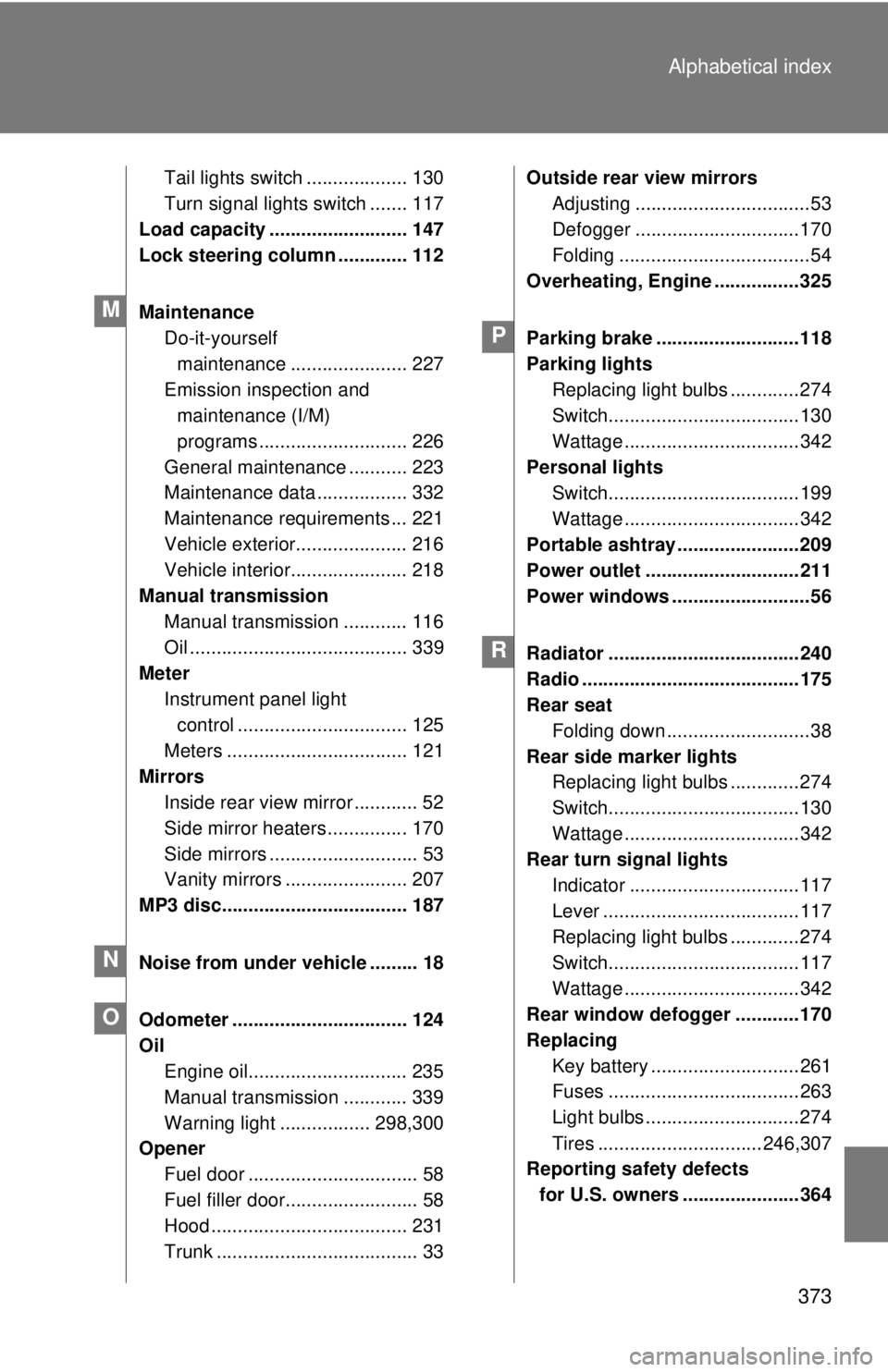
373
Alphabetical index
Tail lights switch ................... 130
Turn signal lights switch ....... 117
Load capacity .......................... 147
Lock steering column ............. 112
Maintenance Do-it-yourself
maintenance ...................... 227
Emission inspection and maintenance (I/M)
programs ............................ 226
General maintenance ........... 223
Maintenance data ................. 332
Maintenance requirements ... 221
Vehicle exterior..................... 216
Vehicle interior...................... 218
Manual transmission Manual transmission ............ 116
Oil ......................................... 339
Meter Instrument panel light control ................................ 125
Meters .................................. 121
Mirrors Inside rear view mirror ............ 52
Side mirror heaters ............... 170
Side mirrors ............................ 53
Vanity mirrors ....................... 207
MP3 disc................................... 187
Noise from under vehicle ......... 18
Odometer ................................. 124
Oil Engine oil.............................. 235
Manual transmission ............ 339
Warning light ................. 298,300
Opener
Fuel door ................................ 58
Fuel filler door......................... 58
Hood ..................................... 231
Trunk ...................................... 33 Outside rear view mirrors
Adjusting .................................53
Defogger ...............................170
Folding ....................................54
Overheating, Engine ................325
Parking brake ...........................118
Parking lights
Replacing light bulbs .............274
Switch....................................130
Wattage .................................342
Personal lights Switch....................................199
Wattage .................................342
Portable ashtray .......................209
Power outlet .............................211
Power windows ..........................56
Radiator ....................................240
Radio .........................................175
Rear seat Folding down ...........................38
Rear side marker lights Replacing light bulbs .............274
Switch....................................130
Wattage .................................342
Rear turn signal lights
Indicator ................................117
Lever .....................................117
Replacing light bulbs .............274
Switch....................................117
Wattage .................................342
Rear window defogger ............170
Replacing
Key battery ............................261
Fuses ....................................263
Light bulbs .............................274
Tires ...............................246,307
Reporting safety defects
for U.S. owners ......................364
M
N
O
P
R